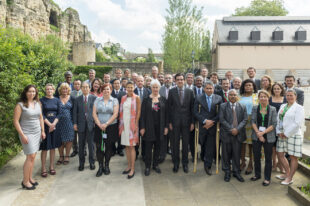Enhancing the Role of Auditing in Building a Safe and Resilient Water Network

Author: Department of Fixed-Assets Investment Audit of the National Audit Office of China
I. Introduction
In China, water security is considered a critical aspect of infrastructure, focusing on optimizing the water resource distribution system and improving the flood control and disaster mitigation system. In 2022, to accelerate the construction of a national water network and build a modern, high-quality water infrastructure network, and to comprehensively address issues of water resources, water ecology, water environment, and water disasters, the Chinese government issued the “National Water Network Construction Planning Outline” (hereinafter referred to as the “Water Network Plan”). In 2023, the National Audit Office of China carried out a special audit on construction and operation of major water diversion projects, aiming to assist in building a safe and resilient modern water network. The audit focused on revealing prominent problems in the construction and operation of major water diversion projects and finding out the systemic barriers, mechanistic defects, and institutional loopholes behind these issues. This article, based on relevant planning and constructions of the national water network, studies key areas that audits should focus on, and discusses experiences, practices of audit, and shares typical cases for reference.
II. Overview of the Water Network Plan and Its Construction
I. Background of the Water Network Plan
China’s water situation has always been characterized by floods in summer and droughts in winter, with water scarcity in the north and abundance in the south. The spatial and temporal distribution of water resources is extremely uneven, with the per capita water resources in China being only 1/4 of the world average, respectively. To form a unified national market and facilitate domestic economic circulation, and to promote coordinated development between the north and south, it is important to strengthen the distribution of water resources across river basins and regions. At the same time, China is frequently hit by floods and droughts. The middle and lower reaches of major rivers are vulnerable to basin-wide floods and strong typhoons, while the central and western regions are threatened by heavy rainfall and mountain torrents. To effectively respond to floods and droughts, it is essential to systematically plan the layout of water infrastructure systems, leverage the advantages and comprehensive benefits of networked water engineering systems for the safety of economy and society.
II. Layout of the National Water Network Construction
According to China’s Water Network Plan, a comprehensive national water network, consisting of backbone, mesh and knot projects, will be completed by 2035. First, efforts will focus on the “backbone projects” of the national water network, based on the main stems of major rivers and important lakes, with the South-to-North Water Diversion Project as a key component. This involves properly advancing the planning and construction of a series of major water diversion, drainage, and discharge projects. Second, the “mesh projects” of the national water network consist of major national and regional water resource distribution projects. This includes promoting comprehensive management of major tributaries and small-to-medium rivers, regional river-lake water system connectivity, and the construction of diversion, drainage, and discharge projects, forming an integrated and interconnected water network pattern for both urban and rural areas. Third, the “knot projects” of the national water network consist of water controlling projects and key water source projects.
III. Progress of National Water Network Project Construction
The Chinese government in recent years has strengthened and improved macro-control, implemented proactive fiscal policies and moderate monetary policies, and fully leveraged the guiding role of fiscal funds to promote water infrastructure investments and financing landscape where fiscal, financial, and social capital work together. National water conservancy construction investment has exceeded one trillion yuan for three consecutive years, with 47,000 water conservancy projects implemented and 1.35 trillion yuan invested in 2024. Currently, with the completion of major projects like the first phases of the South-to-North Water Diversion’s eastern and central routes, and key milestones in the Yangtze-to-Huaihe River Water Diversion, a cross-basin and cross-regional water network is gradually forming. In the coming period, China will accelerate the construction of a national water network that is “systematically complete, safe and reliable, intensive and efficient, green and smart, smoothly circulating, and orderly regulated,” ensuring national water security.
III. Priority Areas for Auditing Major Water Diversion Project
I. Audit of Implementation of Major Plans and Key Projects
As a large-scale and complex systematic project, the national water network involves multiple departments and regions, requiring the coordination of multiple objectives. The coordination of work among water network projects and resource elements, evaluation of water demand, and estimation of water condition changes and their impacts could be challenges. In response to these challenges, auditors should focus on:
Consistency of Plans. Determining whether the “Water Network Plan” aligns with spatial planning, ecological protection, and other policy plans; whether the goals of the “Water Network Plan” are detailed and implemented, key tasks are effectively decomposed, and whether the “backbone,” “mesh,” and “knot” projects included in the plans were progressed in a consistent way.
Implementation of Key Projects. Assessing whether the key projects in the “Water Network Plan” and its detailed implementation plans are progressing as scheduled, and whether there are difficulties or bottlenecks in project approval and construction. Special attention should be paid to whether projects were negatively affected by inconsistent policies, inadequate resources, or lax performance by relevant departments.
II. Audit of Funds Management and Use
Major water diversion projects have significant social benefits, as their implementation strengthens inter-connectivity, enhances water resource allocation capabilities between basins and regions, and improves urban and rural water supply security. Due to their long construction cycles and large scales, these projects require substantial funding. Therefore, audits should focus on:
Compliance of Financing Activities. Given the public welfare nature of these projects, which primarily rely on fiscal funds, auditors should verify whether governments and construction contractors have raised funds through multiple channels as required by feasibility study approvals, whether the proportion of self-raised funds by contractors meets regulations, and whether there are undelivered financing commitment that negatively affected the progress.
Fund Allocation. Auditors should examine whether project budgets, investment plans, and funds are allocated and disbursed in a timely and sufficient manner, whether funds have been misappropriated, and whether fund disbursement and bank loans match project progress. Issues such as excessive idle funds due to over-allocation should also be scrutinized.
Fund Use. Auditors should assess whether fund management is compliant and expenditures are reasonable, and whether there are losses or wastes due to inadequate preliminary work or lax fund management. Issues such as illegal impoundment, delayed refunding of impoundment, and delay in payments to small and medium-sized enterprises and workers should also be investigated.
III. Construction Management
Major water diversion projects, usually involving multiple industries and long supply chains, play a crucial role in addressing infrastructure gaps, and improving employment and people’s well-being. Therefore, auditors should focus on key issues such as project bidding, material and equipment procurement, and quality of projects:
Project Approval. Assessing whether projects are unrealistic, overestimated, or progressed in weak conditions. Issues such as inflating project quantities, lowering construction standards and reducing construction scope without approval should be examined.
Bidding and Contract Management. Identifying whether there are issues such as failure to conduct required bidding, fraudulent bidding, bid-rigging, or illegal subcontracting. Cases of unqualified contractors, inflation of costs, or significant losses due to mismanagement should also be investigated.
Quality Control. Investigating whether there are issues such as cutting corners, unauthorized changes of working scope of main projects. Special attention should be paid to major quality defects caused by inadequate supervision by construction contractors or negligence of supervision duties.
IV. Project Operation, Maintenance, and Performance
To fully unleash the benefits of major water diversion projects, it is essential to improve their construction, operation, and management mechanisms. Some auditees neglected the fact that water diversion projects may not form a synergy without simultaneous completion of supporting facilities such as storage reservoirs and distribution networks, in addition to single conservancy projects. Therefore, auditors should focus on:
Performance of Major Projects. By comparing actual water diversion volumes of a completed project with its planned diversion scales and annual water supply plans, auditors can analyze whether the lack of supporting facilities has led to ill or limited performance of completed projects.
Operation and Maintenance. Auditors can review whether a regular operation and maintenance mechanism has been established, whether quality defects are repaired in a timely manner, and whether efforts are made to separate management and maintenance to reduce costs and improve professional and standardized management levels. Additionally, auditors should examine whether emergency water supply plans for extreme scenarios have been formulated.
Water Fee Collection and Expenditure. Auditors should assess whether the water pricing mechanism is reasonable and conducive to promoting water conservation and the sustainable operation of water projects. Audits should also check whether water fees are collected duly and managed and used in compliance with regulations.
IV. Typical Cases of Auditing Major Water Diversion Projects
I. An Audit Case in Project Approval Process
In auditing a major water diversion project, auditors compared investment estimates, financing plans in feasibility studies, preliminary engineering budgets, bidding budgets, and final accounts at various stages. It was found that the project exaggerated water demand to inflate construction costs in project proposal for acquiring more funds from central fiscal funds. The project was also found reduction of the project scope, lowered standards, and delayed supporting facilities. This not only affected the benefits of the main project but also undermined the effectiveness of government investment in driving broader economic impact. In response, the audit report recommended that relevant managing departments, adhering to principle of “Reality, Eco-friendliness, and Sustainability,” assess water demand in specific areas, deepen the preliminary project study, and accelerate the construction of major national water network projects.
II. An Audit Case in Project Construction Activities
Preliminary survey and engineering are the “root” of quality and safety in construction projects, directly impacting the quality, investment efficiency, and lifespan of the project. In the audit of a major water diversion project, auditors made the project preliminary survey and engineering their audit focus considering the project’s complex geological conditions. By analyzing the consistency of material usage, construction acceptance records, and survey and engineering data, and using technical methods such as ground-penetrating radar and on-site measurements, they found that the project contractor’s survey work was not sufficient. Consequently, the project experienced frequent accidents, delays, and significant economic losses during construction. The auditors recommended the relevant departments should improve the supervision system for survey and engineering in major water projects, enhancing system resilience, and increasing water supply security.
III. An Audit Case in Project Operation and Maintenance Work
Auditors found that some major water diversion projects after completion had poor performance due to the absence of a reasonable water pricing mechanism. In such context, when the water prices were high, end users would continue to over-extract limited underground water in local areas instead of buying water from the market. Conversely, if prices were low, water conservancy projects could not operate effectively due to the fact that they did not generate adequate income. Additionally, some projects lacked advanced management systems and administrative mechanisms for rational water allocation. To address these problems, auditors recommended the relevant departments should build reasonable operation and maintenance mechanisms during the project planning, establish reasonable water pricing mechanisms tailored to local conditions, and ensure sustainable operation of projects.





